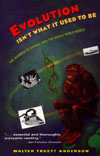
The title is misleading for this book in that it is only peripherally concerned with Charles Darwin’s theory. The subtitle, The Augmented Animal and the Whole Wired World, is only slightly better. The difficulty in naming this book is its interdisciplinary nature. Anderson covers biology, cybernetics, information technology, agriculture, environmentalism, and genetic research. Although all are specialized fields, Anderson shows how they interact with each other cud every one of us. It is an exciting time to be alive, Anderson says.
Like many popular books on science, Evolution Isn’t What It Used to Be starts off slowly. Because Anderson cannot be sure of the background that every reader brings to his book, he spends the first half of each section in a survey of one or two of his inter-connected subjects. Interspersed in the survey are some delectable bits of controversy and discovery, but he saves the items that have the most impact for the last sections. Since the book is organized into four different sections, this makes for a thrilling roller coaster ride through some of the most exiting terrain in science today.
In the first 50 pages, I was somewhat bored by Anderson’s prose (he is no David Quammen) and slightly skeptical of his early opinions. At the halfway point I realized that I was reading much more smoothly and often nodding my head at the text. When I found myself quoting this book at a business meeting the next day, I knew I was learning from this book.
Anderson’s basic thesis is that humans have taken control of their own evolution, and the mechanisms of this control are the convergence of biology and technology, and seen today in the growing field of biotech. I have long thought that information is the opposite of entropy (in a local sense) and Anderson closely dovetails into this idea with his concept of information being the control mechanism by which we modify our biological environment. In a sense we have done this in the past, through the use of corrective lenses and vaccines. But these are only baby steps compared to the strides we may be capable of shortly.
Anderson’s personal background is rooted in the environmental movement (which, if you were unaware of it, you find out in the last section), and his moderate stance on certain issues is quite refreshing compared to the demagoguery we are subjected to daily. While you may disagree with his predictions, it is important to think about and discuss them.
[Finished 20 February 1998]
